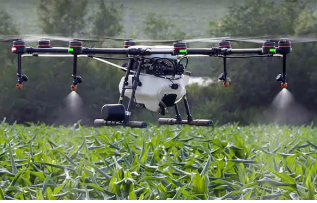In recent years, the agricultural industry has undergone a significant transformation with the integration of advanced technologies. Among these innovations, drones have emerged as a powerful tool, offering farmers new ways to optimize crop production, improve efficiency, and reduce costs. At Drone Division, we understand the immense potential that drones bring to the field of agriculture, and we are committed to helping farmers harness this technology to its fullest. In this article, we will explore some of the most impactful applications of drones in agriculture.
- Crop Monitoring and Health Assessment
One of the most significant advantages of using drones in agriculture is their ability to provide real-time monitoring of crops. Equipped with high-resolution cameras and multispectral sensors, drones can capture detailed images of fields, allowing farmers to assess crop health, growth patterns, and detect early signs of disease or pest infestations. This data is crucial for making informed decisions on irrigation, fertilization, and pest control, ultimately leading to higher crop yields and better-quality produce.
For instance, drones can capture multispectral images that highlight variations in crop health by analyzing the reflectance of different wavelengths of light. Healthy plants reflect more near-infrared light, while stressed or diseased plants reflect less. By identifying these variations early, farmers can take targeted actions to address issues before they spread, reducing the need for widespread pesticide use and preserving crop health.
- Precision Agriculture
Precision agriculture is a farming management concept that relies on observing, measuring, and responding to variability in crops. Drones play a crucial role in this approach by providing detailed maps and data that allow farmers to apply inputs, such as water, fertilizers, and pesticides, only where they are needed. This targeted approach not only reduces waste but also minimizes the environmental impact of farming practices.
For example, drones can create prescription maps that guide variable rate application (VRA) machinery to distribute inputs more efficiently. This results in optimized use of resources, reduced costs, and increased sustainability. Additionally, precision agriculture helps in conserving water by ensuring that irrigation is applied only where it is necessary, reducing the risk of overwatering and waterlogging.
- Soil and Field Analysis
Before planting, understanding the condition of the soil is essential for successful crop production. Drones equipped with specialized sensors can perform detailed soil analysis, providing farmers with valuable information on soil moisture levels, nutrient content, and pH balance. This data helps farmers prepare the soil more effectively, ensuring that it is in the best possible condition for planting.
Drones can also create 3D maps of fields, identifying variations in terrain that may affect planting patterns or water distribution. This information is particularly useful for planning irrigation systems and drainage solutions, leading to more efficient water use and better crop performance.
- Planting and Seeding
Drones are now being used for planting and seeding, especially in difficult-to-reach areas or large-scale operations. By using drones to drop seeds directly into the soil, farmers can save time and labor while ensuring uniform seed distribution. This method is particularly beneficial in reforestation projects and for planting cover crops that prevent soil erosion.
In some cases, drones are equipped with air cannons that shoot seeds into the soil, ensuring that they are embedded at the correct depth. This innovative approach not only speeds up the planting process but also increases the likelihood of successful germination, contributing to higher crop yields.
- Irrigation Management
Efficient water use is a critical aspect of modern farming, especially in regions where water resources are limited. Drones can help farmers manage irrigation more effectively by providing real-time data on soil moisture levels and identifying areas that require additional watering. By using this information, farmers can adjust their irrigation systems to deliver water precisely where it is needed, reducing waste and ensuring that crops receive the optimal amount of moisture.
Drones can also be used to monitor the effectiveness of irrigation systems, detecting leaks or areas of poor water distribution. This allows farmers to address issues promptly, preventing water wastage and ensuring that crops are evenly watered.
- Crop Spraying
Another significant application of drones in agriculture is crop spraying. Drones equipped with sprayers can apply pesticides, herbicides, and fertilizers with pinpoint accuracy, reducing the risk of over-application and minimizing chemical runoff. This method is particularly useful in uneven or difficult-to-access terrain, where traditional spraying methods may be less effective.
By using drones for crop spraying, farmers can reduce their reliance on heavy machinery, lower their operational costs, and decrease the environmental impact of their farming practices. Moreover, agriculture drone spraying can be completed much faster than traditional methods, allowing for timely application and reducing the risk of crop damage.
Conclusion
The integration of drones into agriculture is revolutionizing the way farmers manage their fields. From monitoring crop health to optimizing resource use, drones offer a wide range of applications that enhance efficiency, reduce costs, and promote sustainable farming practices. At Drone Division, we are dedicated to helping farmers leverage this cutting-edge technology to improve their operations and achieve better outcomes. As drone technology continues to evolve, the possibilities for its application in agriculture are limitless, paving the way for a more productive and sustainable future in farming.

